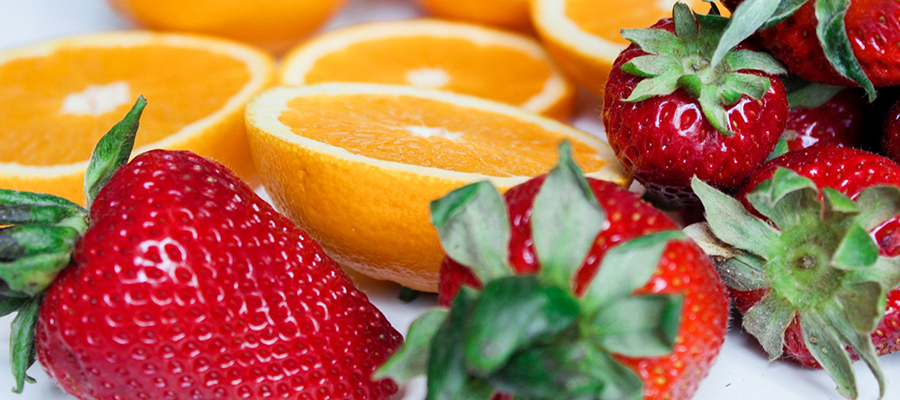Image source: pexels.com
Vitamin C (Ascorbic Acid)
Figure 37: Vitamin C is an important antioxidant. Peaches, grapes, and tomatoes are good sources, but rose hips are one of the best sources.
Usually measured in milligrams (mg)
Functions
Vitamin C is an important antioxidant and general health promoter. Ascorbic acid is the functional form of vitamin C. It assists with the formation of collagen, the “intercellular glue” that holds the body together. It protects against stress, pollutants, and drugs, and is a natural antibiotic. It is necessary for the correct functioning of the adrenal glands and thyroid and for healthy teeth, gums, and bones.
Most recently it is making headlines in the fight against COVID-19. Reports say that intravenous (IV) vitamin C may help people suffering from this disease.[1] We know that the immune system requires numerous vitamins and minerals including vitamin C. Healthy neutrophils and macrophages contain 1 mM concentrations of vitamin C—that’s 50-100 times higher than the concentration of vitamin C in the plasma the liquid part of the blood. A healthy person produces about 100 billion neutrophils per day. However, when the immune system detects germs and swings into action to destroy the invaders, its white blood cell production—and its need for vitamin C—increases.[2] It is now the recommendation of the government of Shanghai, China that COVID-19 should be treated with high amounts of intravenous vitamin C and there are three trials[3] [4] [5]currently underway in China.[6] For more information and specific instructions visit the Orthomolecular organization website.[7] [A1]
Absorption and Storage
Vitamin C (ascorbic acid) is derived from glucose in many species, but not all. Primates, including humans, lack the enzyme necessary for this conversion so must obtain ascorbic acid from their diet.
Ascorbic acid itself is rather unstable and is quickly oxidized to dehydroascorbic acid. It therefore acts as a reducing agent. A compound can either be oxidized or reduced. Vitamin C’s reputation as an “antioxidant” comes from the fact that it is able to reduce other substances. Vitamin C, as a water-soluble antioxidant, may inhibit the formation of dangerous nitrosamines during digestion.
When fats (lipids) are exposed to oxygen, it causes a chain reaction known as lipid peroxidation. These altered lipids are very damaging to tissues, contributing to cancer, inflammation, heart disease, and aging. Vitamin C can reduce the initiation of the chain reaction. Other antioxidants, such as vitamin E, can break the chain after it has begun. When vitamin E is oxidized to break the chain, it is reduced again by vitamin C so it can continue to function. This is why it is important to have both vitamin C and E in your diet.
Vitamin C acts indirectly in reactions in which a metal cofactor is needed, such as copper, iron, manganese, and magnesium. In most reactions using a metal, the metal must be in the reduced state to function, such as Cu+ or Fe ++, and this state is maintained with the help of vitamin C. The adrenal gland uses large amounts of vitamin C during steroid hormone synthesis.
Vitamin C is destroyed by air, storage, smoking, cooking, and stress.
Deficiency Symptoms
Deficiency symptoms include tooth decay, soft and bleeding gums, capillary weakness, easy bruising, slow wound healing, premature aging, tender painful swollen joints, reduced secretion of adrenals, poor lactation, and low resistance to infection.
Vitamin C has many therapeutic uses. The 2000 report from the National Institute of Health[8] noted its importance as an antioxidant in the prevention of chronic illness. In particular, they noted epidemiological studies showing lower rates of cardiovascular disease, in particular of coronary heart disease, cataracts, and age-related macular degeneration. They noted positive results from small intervention trials with vitamin C for common neurodegenerative diseases such as Alzheimer’s, Parkinson’s, and amyotrophic lateral sclerosis. They also noted the use of vitamin C for reducing the risk of cancer and for assisting with diabetes, concluding that while some evidence pointed to a benefit, more research needs to be conducted before they can make a definitive finding.
Sources
Humans are one of the few mammals that cannot produce vitamin C. Vitamin C-rich foods include rose hips Rosa canina (L.), citrus fruits, berries, melons, cabbage, parsley, sprouts, tomatoes, potatoes, and peppers.
Dietary Reference Intakes[9]
NOTE: This table presents either Recommended Dietary Allowances (RDAs) or Adequate Intakes (AIs). Where AI is used, it is followed by an asterisk (*).[10]
|
Age |
RDA/AI* mg |
UL mg |
|
0 to 6 months |
40* |
|
|
7 to 12 months |
50* |
|
|
1 to 3 years |
15 |
400 |
|
4 to 8 years |
25 |
650 |
|
Male 9 to 13 years |
45 |
1,200 |
|
Male 14 to 18 years |
75 |
1,800 |
|
Male 19+ years |
90 |
2,000 |
|
Female 9 to 13 years |
45 |
1,200 |
|
Female 14 to 18 years |
65 |
1,800 |
|
Female 19+ years |
75 |
2,000 |
|
Pregnancy <19 years |
80 |
1,800 |
|
Pregnancy 19+ years |
85 |
2,000 |
|
Lactation <19 years |
115 |
1,800 |
|
Lactation 19+ years |
120 |
2,000 |
Therapeutic Dose
100 to 5,000 milligrams a day
In acute poisoning or infections: 500 to 2,000 milligrams every one to two hours. It is best taken with bioflavonoids. Smaller doses taken more frequently are more effective.
Supplement Cautions
Since vitamin C is water soluble, it does not build up in the body. High doses can cause temporary gastrointestinal discomfort, diarrhea, nausea, and possibly stomach cramping. People react to different levels of vitamin C. Some can experience discomfort at levels over 600 milligrams, others have no problems with 25,000 milligrams. To avoid discomfort, take smaller amounts more frequently.
[1] Is IV vitamin C effective against COVID-19?. Linus Pauling Institute. (2020). Retrieved 4 August 2020, from https://lpi.oregonstate.edu/COVID19/IV-VitaminC-virus.
[2] Carr AC, Frei B. Toward a new recommended dietary allowance for vitamin C based on antioxidant and health effects in humans. Am J Clin Nutr 1999;69:1086-107.
[3] Cheng R., M.D., Ph.D., (2020). NCP(Novel Coronavirus Pneumonia) and Vitamin C. https://www.youtube.com/. Retrieved 4 August 2020, from https://www.youtube.com/watch?v=TC0SO9KDG7U.
[4] Saul, A., & Yanagisawa, MD, PhD, A. (2020). Early Large Dose Intravenous Vitamin C is the Treatment of Choice for 2019-nCov Pneumonia. Orthomolecular.org. Retrieved 4 August 2020, from http://www.orthomolecular.org/resources/omns/v16n11.shtml.
[5] Cheng R., M.D., Ph.D., D. (2020). The 3rd Large Dose VIt C Clinical Study for NCP Approved. https://www.youtube.com/. Retrieved 4 August 2020, from https://www.youtube.com/watch?v=VMDX0RSDp1k.
[6] Passwater, Ph.D., R. (2020). Vitamin C and the Immune System: Nutritional Fortification to Support Defenses Against Viruses. Retrieved 4 August 2020, from https://wholefoodsmagazine.com/columns/vitamin-connection/vitamin-c-and-the-immune-system-nutritional-fortification-to-support-defenses-against-viruses/
[7] Hospital-based Intravenous Vitamin C Treatment for Coronavirus and Related Illnesses. Orthomolecular.org. (2020). Retrieved 4 August 2020, from http://www.orthomolecular.org/resources/omns/v16n07.shtml
[8] Dietary Reference Intakes for vitamin C, vitamin E, Selenium and Carotenoids, Panel on Dietary Antioxidants and Related Compounds, Subcommittee on Upper Reference Levels of Nutrients and Interpretation and Uses of Dietary Reference Intakes, Standing Committee on the Scientific Evaluation of Dietary Reference Intakes, Food and Nutrition Board, Institute of Medicine, National Academy Press, Washington, D.C. 2000.
[9] Dietary Reference Intakes for vitamin C, vitamin E, Selenium and Carotenoids, Panel on Dietary Antioxidants and Related Compounds, Subcommittee on Upper Reference Levels of Nutrients and Interpretation and Uses of Dietary Reference Intakes, Standing Committee on the Scientific Evaluation of Dietary Reference Intakes, Food and Nutrition Board, Institute of Medicine, National Academy Press, Washington, D.C. 2000.
[10] Institute of Medicine. (2005). Dietary references intakes for energy, carbohydrate, fiber, fat, fatty acids, cholesterol, protein, and amino acids. The National Academies Press. https://doi.org/10.17226/10490.
[A1]TBA new content






